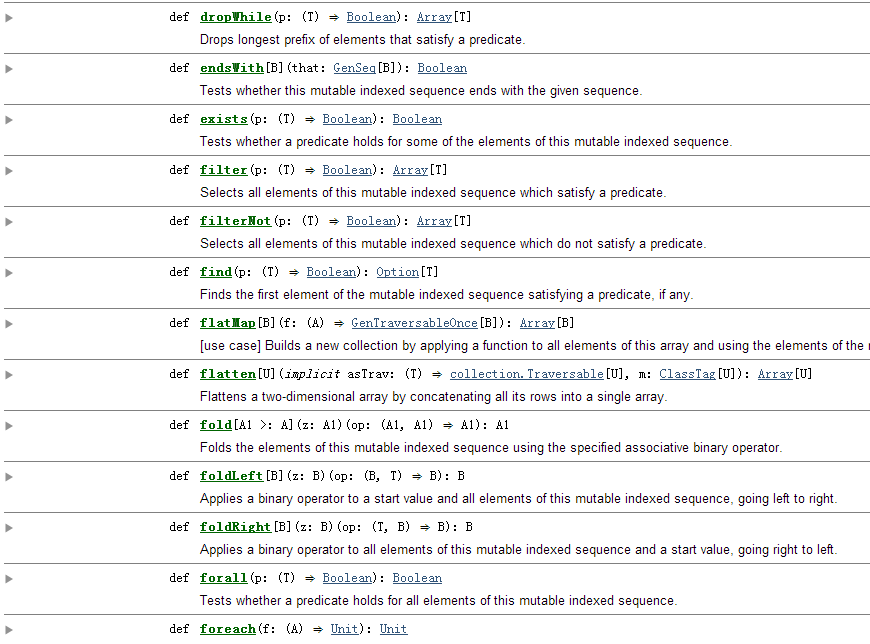本节主要内容
- 高阶函数简介
- Scala中的常用高阶函数
- SAM转换
- 函数柯里化
- 部分应用函数
1. 高阶函数简介
高阶函数主要有两种:一种是将一个函数当做另外一个函数的参数(即函数参数);另外一种是返回值是函数的函数。这两种在本教程的第五节 函数与闭包中已经有所涉及,这里简单地回顾一下:
(1)函数参数
//函数参数,即传入另一个函数的参数是函数
//((Int)=>String)=>String
scala> def convertIntToString(f:(Int)=>String)=f(4)
convertIntToString: (f: Int => String)String
scala> convertIntToString((x:Int)=>x+" s")
res32: String = 4 s(2)返回值是函数的函数
//高阶函数可以产生新的函数,即我们讲的函数返回值是一个函数
//(Double)=>((Double)=>Double)
scala> def multiplyBy(factor:Double)=(x:Double)=>factor*x
multiplyBy: (factor: Double)Double => Double
scala> val x=multiplyBy(10)
x: Double => Double = <function1>
scala> x(50)
res33: Double = 500.0 Scala中的高阶函数可以说是无处不在,这点可以在Scala中的API文档中得到验证,下图给出的是Array数组的需要函数作为参数的API:

例如flatMap方法,下面是其API的详细内容:
def
flatMap[B](f: (A) ⇒ GenTraversableOnce[B]): Array[B]
[use case]
Builds a new collection by applying a function to all elements of this array and using the elements of the resulting collections.
//下面的代码给出了该函数的用法
For example:
def getWords(lines: Seq[String]): Seq[String] = lines flatMap (line => line split "\\W+")
The type of the resulting collection is guided by the static type of array. This might cause unexpected results sometimes. For example:
// lettersOf will return a Seq[Char] of likely repeated letters, instead of a Set
def lettersOf(words: Seq[String]) = words flatMap (word => word.toSet)
// lettersOf will return a Set[Char], not a Seq
def lettersOf(words: Seq[String]) = words.toSet flatMap (word => word.toSeq)
// xs will be a an Iterable[Int]
val xs = Map("a" -> List(11,111), "b" -> List(22,222)).flatMap(_._2)
// ys will be a Map[Int, Int]
val ys = Map("a" -> List(1 -> 11,1 -> 111), "b" -> List(2 -> 22,2 -> 222)).flatMap(_._2)
//下面几行对该函数的参数进行了说明
B
the element type of the returned collection.
//指明f是函数,该函数传入的参数类型是A,返回类型是GenTraversableOnce[B]
f
the function to apply to each element.
returns
a new array resulting from applying the given collection-valued function f to each element of this array and concatenating the results.2. Scala中的常用高阶函数
1 map函数
所有集合类型都存在map函数,例如Array的map函数的API具有如下形式:
def map[B](f: (A) ⇒ B): Array[B]
用途:Builds a new collection by applying a function to all elements of this array.
B的含义:the element type of the returned collection.
f的含义:the function to apply to each element.
返回:a new array resulting from applying the given function f to each element of this array and collecting the results.//这里面采用的是匿名函数的形式,字符串*n得到的是重复的n个字符串,这是scala中String操作的一个特点
scala> Array("spark",







 本文深入讲解Scala中的高阶函数,包括函数简介、常用高阶函数如map、flatMap、filter等的使用,SAM转换减少GUI编程的样板代码,函数柯里化原理与应用,以及部分应用函数的概念和示例。通过这些概念,帮助读者更好地理解和运用Scala的函数特性。
本文深入讲解Scala中的高阶函数,包括函数简介、常用高阶函数如map、flatMap、filter等的使用,SAM转换减少GUI编程的样板代码,函数柯里化原理与应用,以及部分应用函数的概念和示例。通过这些概念,帮助读者更好地理解和运用Scala的函数特性。
 最低0.47元/天 解锁文章
最低0.47元/天 解锁文章















 1268
1268

 被折叠的 条评论
为什么被折叠?
被折叠的 条评论
为什么被折叠?








